History, Art & Culture: April 2024 Current Affairs | General Test Preparation for CUET UG - CUET Commerce PDF Download
900-Year-Old Chalukyan Inscription

Context
A neglected 900-year-old Kannada inscription from the Kalyani Chalukya dynasty was recently found in Gangapuram, Telangana. This inscription was issued by Customs Officers during the reign of Tailapa-III, the son of Emperor Someswara-III (also known as 'Bhulokamalla') of the Kalyani Chalukya dynasty.
Who were the Chalukyas?
- Overview:
- The Chalukyas ruled parts of Southern and Central India between the 6th century and the 12th century.
- The kingdom of Chalukyas was centred around the Raichur Doab, between the Krishna and Tungabhadra rivers.
- Three distinct but related Chalukya dynasties:
- Badami Chalukyas: They were the earliest Chalukyas with their capital at Badami (Vatapi) in Karnataka.
- Their rule started in the mid-6th century and declined after the death of their greatest king, Pulakesin II in 642 AD.
- Eastern Chalukyas: Emerged after the death of Pulakesin II in Eastern Deccan with the capital at Vengi.
- They ruled till the 11th century.
- Western Chalukyas: They were the descendants of the Badami Chalukyas.
- They emerged in the late 10th century and ruled from Kalyani.
- Administration and Cultural Contributions:
- Robust Military: Comprehensive army with infantry, cavalry, elephant unit, and a strong navy.
- Religious Tolerance: Despite being Hindu rulers, they showed tolerance towards Buddhism and Jainism.
- Literary and Numismatic Contributions: Advanced developments in Kannada and Telugu literature.
- Coins featured Nagari and Kannada inscriptions, temple cryptograms, and symbols like lions, boars, and lotuses.
- Architectural Marvels:
- Cave Temples: Built temples with both religious and secular themes adorned with beautiful mural paintings.
- Notable Temples:
- Aihole temples: Lady Khan (Surya), Durga, Huchimalligudi.
- Badami temples.
- Pattadakal Temples: The UNESCO World Heritage site features 10 temples in both Nagar and Dravida styles, including the Virupaksha and Sangameshwara Temples.
- Aihole Inscription of Pulakesin II:
- Situated in the Megudi temple at Aihole, Karnataka, the Aihole inscription provides invaluable insights into Chalukya history and achievements.
- Aihole is considered the “Cradle of Indian temple architecture”.
- Crafted by the renowned poet Ravikriti, the inscription is a lyrical tribute to the Chalukya dynasty, particularly King Pulakesin II, lauded as the embodiment of truth (Sathyasraya).
- The inscription chronicles the Chalukya dynasty's triumphs over adversaries, including the renowned defeat of Harshavardhana.
- Decline:
- After the decline of the Chalukya Kingdom of Kalyani at the end of 12th century, the new kingdoms which arose in South India were Yadavas of Devagiri and Kakatiyas of Warangal and Hoysalas of Dwarasamudra and Pandyas of Madurai.
100 Years of Vaikom Satyagraha
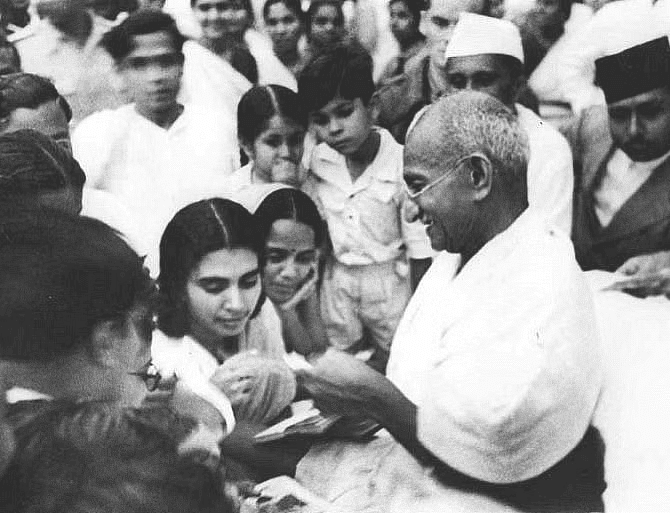
Context
India recently marked the 100th anniversary of the Vaikom satyagraha, a significant movement in India's history that opposed untouchability and caste-based oppression.
What is Vaikom Satyagraha?
- Background:
- The Vaikom Satyagraha, a peaceful protest, unfolded in Vaikom within the princely state of Travancore, Kerala exactly one hundred years ago, from March 30, 1924, to November 23, 1925. This movement stood as a powerful challenge against entrenched practices of untouchability and caste discrimination that had long afflicted Indian society.
- It was sparked by the prohibition of people from oppressed classes, particularly Ezhavas, from using the roads around the Vaikom Mahadeva temple. Efforts were made to negotiate with authorities, including the Maharani Regent of Travancore, to open these temple roads. It marked the first of the temple entry movements in India, setting the stage for similar movements across the nation. The movement emerged amidst the growing nationalist sentiment and aimed to prioritize social reform alongside political aspirations.
- Key Figures:
- Visionary leaders like Ezhava leader T K Madhavan, K.P. Kesava Menon, and K. Kelappan led the movement. Erode Venkatappa Ramasamy, known as Periyar or Thanthai Periyar, played a crucial role by mobilizing volunteers, delivering speeches, and enduring imprisonment, earning the title 'Vaikom Veerar'.
- The movement gained momentum when Mahatma Gandhi visited Vaikom in March 1925 and engaged in discussions with leaders of various caste groups.
- Strategies and Initiatives:
- The satyagraha initially focused on opening the roads surrounding the Vaikom temple to people of all castes.
- Leaders of the movement strategically adopted nonviolent methods, inspired by Gandhian principles of protest.
- Outcome:
- The Vaikom Satyagraha resulted in significant reforms, including the opening of three out of four roads surrounding the temple to people of all castes.
- Aftermath and Legacy:
- In November 1936, the Maharaja of Travancore signed the historic Temple Entry Proclamation, which abolished the age-old ban on the entry of marginalized castes into the temples of Travancore.
- The Vaikom Satyagraha triggered differing perspectives, with some viewing it as a Hindu reformist movement and others as a fight against caste-based injustices. Memorials such as the Vaikom Satyagraha Memorial Museum and Periyar's Memorial were established to commemorate the movement's significance.
Konda Reddi Tribe
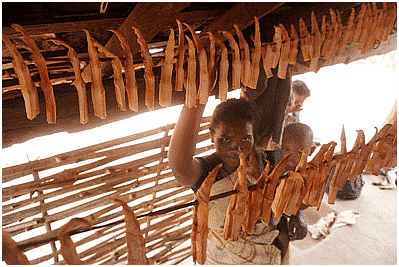
Context
The traditional knowledge of the Konda Reddi tribe, a Particularly Vulnerable Tribal Group living in the Papikonda hill range in the Godavari region, has demonstrated its valuable resourcefulness.
About Konda Reddi Tribe
The Konda Reddis are a Particularly Vulnerable Tribal Group residing along the banks of the Godavari River and in the hilly forest areas of Godavari and Khammam districts in Andhra Pradesh. They primarily speak Telugu in its purest and unique form.
- Subdivisions:
- The Konda Reddi tribe is divided into exogamous septs to regulate matrimonial relationships, similar to other Telugu-speaking communities. They use surnames prefixed to individual names, and while most septs are exogamous, certain septs are considered brother septs, prohibiting marriage alliances within these agnate relations.
- Family and Marriage:
- Their society is patriarchal and patrilocal, generally adhering to monogamy although polygamous families exist. Marriage can occur through negotiation, love and elopement, service, capture, or exchange.
- Religion:
- The Konda Reddis primarily practice Folk Hinduism, centered around local traditions and the worship of community-level deities.
- Political Organization:
- They maintain a social control institution called the ‘Kula Panchayat’ and each village is led by a traditional headman known as ‘Pedda Kapu’. This leadership role is hereditary, and the headman also serves as the village deity's priest.
- Livelihood:
- Their primary occupation is shifting cultivation, relying heavily on forest resources for sustenance. They gather and sell non-timber forest products like tamarind, adda leaves, myrobolan, and broom sticks to supplement their income. Jowar cultivation is a significant part of their subsistence, serving as their staple food.
Rakhigarhi Findings in NCERT Books Added

Context
The National Council of Educational Research and Training (NCERT) has suggested incorporating details regarding the DNA analysis of skeletal remains discovered at Rakhigarhi into their curriculum.

About Rakhigarhi
- The ancient site of Rakhi-Khas and Rakhi-Shahpur are collectively known as Rakhigarhi, located on the right bank of the now dried up Palaeo-channel of Drishadvati.
- It is located in the Ghaggar-Hakra River plain in the Hissar district of Haryana.
- Total seven mounds are located here.
- The site has yielded various stages of Harappan culture and is by far one of the largest Harappan sites in India.
- The site shows the sequential development of the Indus culture in the now dried-up Saraswati basin.
Major findings at Rakhigarhi
- Findings confirm both early and mature Harappan phases and include 4,600-year-old human skeletons, fortification and bricks.
- Digging so far reveals a well-planned city with 92 m wide roads, a bit wider than in Kalibangan.
- The pottery is similar to Kalibangan and Banawali.
- Pits surrounded by walls have been found, which are thought to be for sacrificial or some religious ceremonies.
- There are brick-lined drains to handle sewage from the houses.
- Terracotta statues, weights, bronze artefacts, comb, copper fish hooks, needles and terracotta seals have also been found.
- A bronze vessel has been found which is decorated with gold and silver.
- A granary belonging to the mature Harappan phase has been found here.
- Fire altars structures were revealed in Rakhigarhi.
Phanigiri
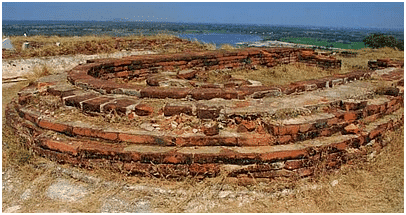
Context
Recently, the Department of Archaeology and Museums uncovered a collection of coins at the Phanigiri site in the Suryapet district of Telangana.
About Phanigiri
- It is a famous Buddhist site located 110 km away from Hyderabad.
- This site derived its name from the shape of the hillock, which appears to be like a snake hood. The word Phani in Sanskrit means snake and Giri means hillock.
- It is believed to be one of the important Buddhist monasteries strategically located on the ancient trade route (Dakshinapatha) connecting the west and the east coast of the Deccan.
Other findings of the excavation
- Coins: Lead coins with elephant symbol on one side and Ujjain symbol on the other side are found.
- According to the archaeologists, the coins belong to the Ikshvaku period dated between 3rd century and 4th century Common Era.
- Also stone beads, glass beads, shell bangle fragments, stucco motifs, broken limestone sculptures, a wheel of a toy cart, final nails and pottery are excavated.
- Mahastupa, apsidal Chaityagrihas, Votive stupas, pillared congregation halls, Viharas, platforms with staircases at various levels, octagonal stupa chaitya, 24-pillared mandapam, circular chaitya, and cultural materials that included terracotta beads, semi-precious beads, iron objects, Brahmi label inscriptions and holy relic casket are also excavated.
- All the cultural material is datable from the 1st century BCE to 4th century CE.
Science Behind Surya Tilak Ceremony

Context
On the occasion of Ram Navami, ‘Surya Abhishek’ of Ram Lalla in Ayodhya temple was held precisely at noon for about three minutes on April 17.
- The 'Surya Tilak' or 'Surya Abhishek' is when a beam of sunlight is directed onto the idol's forehead on a specific day, which in this case is Ram Navami, considered to be Lord Ram's birthday, typically falling in March or April.
- This year marks the first Ram Navami since the installation of the Ram idol at the new temple on January 22. The scientists tested the system on Tuesday to ensure its effectiveness.
58 cm tilak, lasting a little over 3 minutes
- The planned tilak size is 58 mm. The exact period of tilak on the forehead centre is about three to three-and-a-half minutes, with two minutes of full illumination.
What if it is a cloudy day
"That's the limitation. scientists don't wish to do with artificial light because of the faith and belief of our people."
Developed by CBRI
- The detailed complete design in consultation with the Indian Institute of Astrophysics (IIA), Bangalore, the CSIR-CBRI, Roorkee team has developed a mechanism for a period of 19 years for sunlight to reach from the third floor of the temple to the 'Garbha Griha'.
- The fabrication of optical elements, pipes, tilt mechanism and other related components are carried out by Optics and Allied Engg Pvt Ltd (Optica), a Bangalore-based company.
- Pilot done
- The CSIR-CBRI, Roorkee team along with IIA Bangalore and Optica Bangalore completed the installation in the first week of April, and repeated trials have been done.
What is an opto-mechanical system?

- The opto-mechanical system comprises 4 mirrors and 4 lenses integrated into the tilt mechanism and piping systems. A complete cover with an aperture for the tilt mechanism is positioned on the top floor to redirect sunlight through mirrors and lenses into the garbhagriha. The last lens and mirror concentrate the sunlight onto the forehead of Shri Ram, facing east.
- The tilt mechanism adjusts the orientation of the first mirror to direct sunlight towards the north, reflecting it to the second mirror to perform the Surya Tilak ritual every year on Shri Ram Navami day. All piping and components are crafted from brass.
- The mirrors and lenses utilized are of exceptional quality and designed for long-term durability. The inner surfaces of pipes, elbows, and enclosures are coated with black powder to prevent scattering of sunlight. Additionally, an IR (infra-red) filter glass is employed at the top aperture to limit the transmission of heat waves from the Sun onto the idol's forehead.
World Craft City Programme
The World Crafts Council International (WCCI) has picked Srinagar for mapping its craft clusters before its final nomination as the World Craft City (WCC) from India this year.
About World Crafts Council International
- It is a Kuwait-based organisation working on recognition and preservation of traditional crafts across the globe.
- It was founded by Ms. Aileen Osborn Vanderbilt Webb, Ms. Margaret M. Patch, and Smt Kamaladevi Chattopadhyay at the 1st World Crafts Council General Assembly in New York on June 12, 1964.
- Since its inception, the World Crafts Council AISBL has been affiliated with UNESCO under Consultative Status for many years.
- Objective: The main objective of the World Crafts Council AISBL is to strengthen the status of crafts in cultural and economic life.
- Aim: It aims to promote fellowship among crafts persons by offering them encouragement, help and advice.
- It fosters and assists cultural exchange through conferences, international visits, research study, lectures, workshops, exhibitions and other activities.
Key facts about the World Craft City Programme
- It is a groundbreaking initiative launched in 2014 by the World Crafts Council AISBL (WCC-International) in recognition of the pivotal role local authorities, craftspeople, and communities play in cultural, economic, and social development worldwide.
- It establishes a dynamic network of craft cities across the globe, aligning with the principles of the creative economy.
- It responds to the increasing acknowledgment of the valuable contributions made by local entities to the multifaceted dimensions of development.
- Under this initiatives Jaipur (Rajasthan), Mammalapuram (Tamil Nadu) and Mysore have been added already as craft cities from India.
Key facts about Kashmir Craft
- Kashmir’s craft is mostly influenced by Central Asian countries, which are in the list of the WCC.
- The distinction of being included in the WCC list will put a spotlight on Srinagar’s craft scene and introduce the centuries-old processes to the global stage.
World Heritage Day
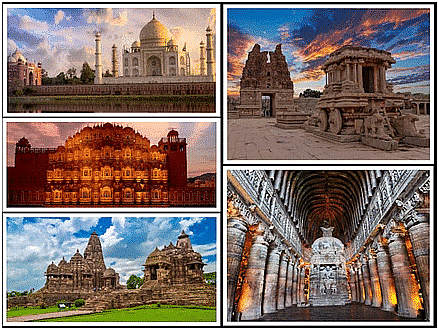
Context
Recently, world heritage day was celebrated across the world.
About
- It is also referred to as International Day for Monuments and it is observed on April 18.
- Objective: To raise awareness about monuments and other sites which form a part of our history and culture.
- Background
- In 1982, The International Council on Monuments and Sites (ICOMOS) proposed the idea of observing World Heritage Day on April 18 every year. The following year, the proposal was approved at UNESCO's General Conference.
- Theme of 2024: The theme for this year's World Heritage Day is - Discover and experience diversity.
- Significance
- The purpose of World Heritage Day is to raise awareness among local communities about protecting our cultural heritage. People from various places and backgrounds come together and exchange knowledge about their histories and customs.
What is the International Council on Monuments and Sites?
- It is a non-governmental organization, was founded in 1965 after the adoption of the Charter of Venice, in order to promote the doctrine and the techniques of conservation.
- It provides the World Heritage Committee with evaluations of properties with cultural values proposed for inscription on the World Heritage List, as well as with comparative studies, technical assistance and reports on the state of conservation of inscribed properties.
2550th Mahaveer Nirvan Mahotsav
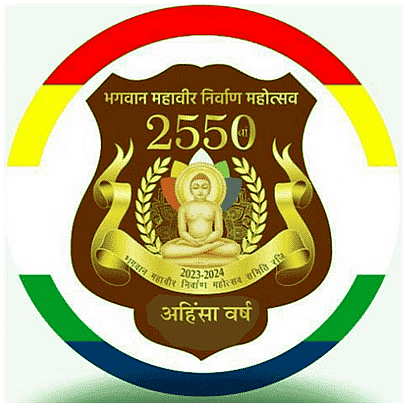
Context
The Prime Minister has inaugurated the 2550th Bhagwan Mahavir Nirvan Mahotsav on the occasion of Mahavir Jayanti.
About Vardhaman Mahavir
- Birth: Born in 540 B.C. Birthplace was Kundagrama village near Vaishali.
- Family Background: Belonged to the Jnatrika clan; father Siddharta was the head of the Jnathrika Kshatriya clan, and mother Trishala was a sister of Chetaka, the king of Vaishali.
- Renunciation: Left home at the age of 30 to become an ascetic.
- Spiritual Practice: Practiced austerity for 12 years.
- Attainment of Kaivalya: Achieved the highest spiritual knowledge called Kaivalya (conquering misery and happiness) at the age of 42.
- First Sermon: Delivered his first sermon at Pava.
- Symbol: Associated with the symbol of a Lion.
- Missions: Traveled to various regions including Koshala, Magadha, Mithila, Champa, etc.
- Passing Away: Passed away at the age of 72 in 468 B.C. at Pavapuri in Bihar.
- Legacy: Founded Jainism as it is known today; contributed significant teachings and principles to the religion.
Everything you need to know about Jainism
- Origin: Jainism gained prominence in the 6th century B.C. when Lord Mahavira propagated the religion.
- Founder: Lord Mahavira, the 24th Tirthankara, is the central figure.
- Tirthankaras: Jainism recognizes 24 Tirthankaras or great teachers, with Rishabhanatha being the first and Mahavira the last.
- Main Principles: Jainism emphasizes the Three Jewels or Triratna: Right Faith (Samyakdarshana), Right Knowledge (Samyakjnana), and Right Conduct (Samyakcharita).
- Five Doctrines: Fundamental principles of Jainism include Ahimsa (non-violence), Satya (truthfulness), Asteya (non-stealing), Aparigraha (non-attachment), and Brahmacharya (chastity).
- Concept of God: Jainism does not adhere to the concept of a creator God but believes in liberated souls (Siddhas) who have attained spiritual perfection.
- Major Doctrines: Anekantavada and Syadvada are important Jain doctrines emphasizing non-absolutism and conditional truth perspectives.
- Sects/Schools: Jainism is divided into two major sects: Digambara (sky-clad) and Svetambara (white-clad).
- Spread: Jainism spread into regions with weak Brahmanical influence and received royal patronage from rulers like Chandragupta Maurya.
- Literature: Jain literature comprises Agama (canonical) texts and Non-agama (commentaries and elaborations) works.
- Architecture: Jain architecture includes temples, caves, statues, and ornamental pillars, showcasing intricate craftsmanship and religious motifs.
- Jain Councils: Significant Jain councils were held for compiling and preserving Jain scriptures and teachings.
- Difference from Buddhism: Jainism differs from Buddhism in its acknowledgment of a permanent self (atman), acceptance of the varna system, belief in the soul (jiva), and advocacy of extreme asceticism.
- Thoughts on Rebirth: Jainism teaches the doctrine of rebirth (samsara) and various realms of existence (lokas) based on karma, with souls cyclically transmigrating through different life forms.
Indian Historical Records Commission
Context
The Indian Historical Records Commission (IHRC) has unveiled a new logo and motto.
Establishment and Role
- Founded in 1919, the IHRC serves as the primary advisory body on archival affairs in India. It functions as a platform for record creators, custodians, and users to advise the Government of India on record management and historical research.
- Leadership and Structure: The commission is overseen by the Union Minister of Culture, underscoring its national importance.
Logo and Motto Competition
- Competition Launch: In 2023, an online competition was initiated on the MyGov portal to create the logo and motto for IHRC (Indian Historical Records Commission). The objective was to visually capture the distinctive identity and ethos of IHRC.
Logo Design and Symbolism
- Design Features: The logo incorporates pages resembling lotus petals, symbolizing IHRC's resilience in preserving historical records. At the center is the Sarnath pillar, representing India's profound historical heritage. The color theme of brown underscores the organization's commitment to preserving, studying, and honoring India's historical legacy.
Motto and Significance
- Translation and Meaning: The motto translates to "Where history is preserved for the future." It underscores IHRC's pivotal role in identifying, collecting, cataloging, and safeguarding historical documents and manuscripts. The motto epitomizes the commission's dedication to conserving invaluable historical knowledge for current and future generations. The IHRC's logo and motto encapsulate its fundamental mission of safeguarding and upholding India's rich historical records for the benefit of future generations.
|
164 videos|798 docs|1153 tests
|





















